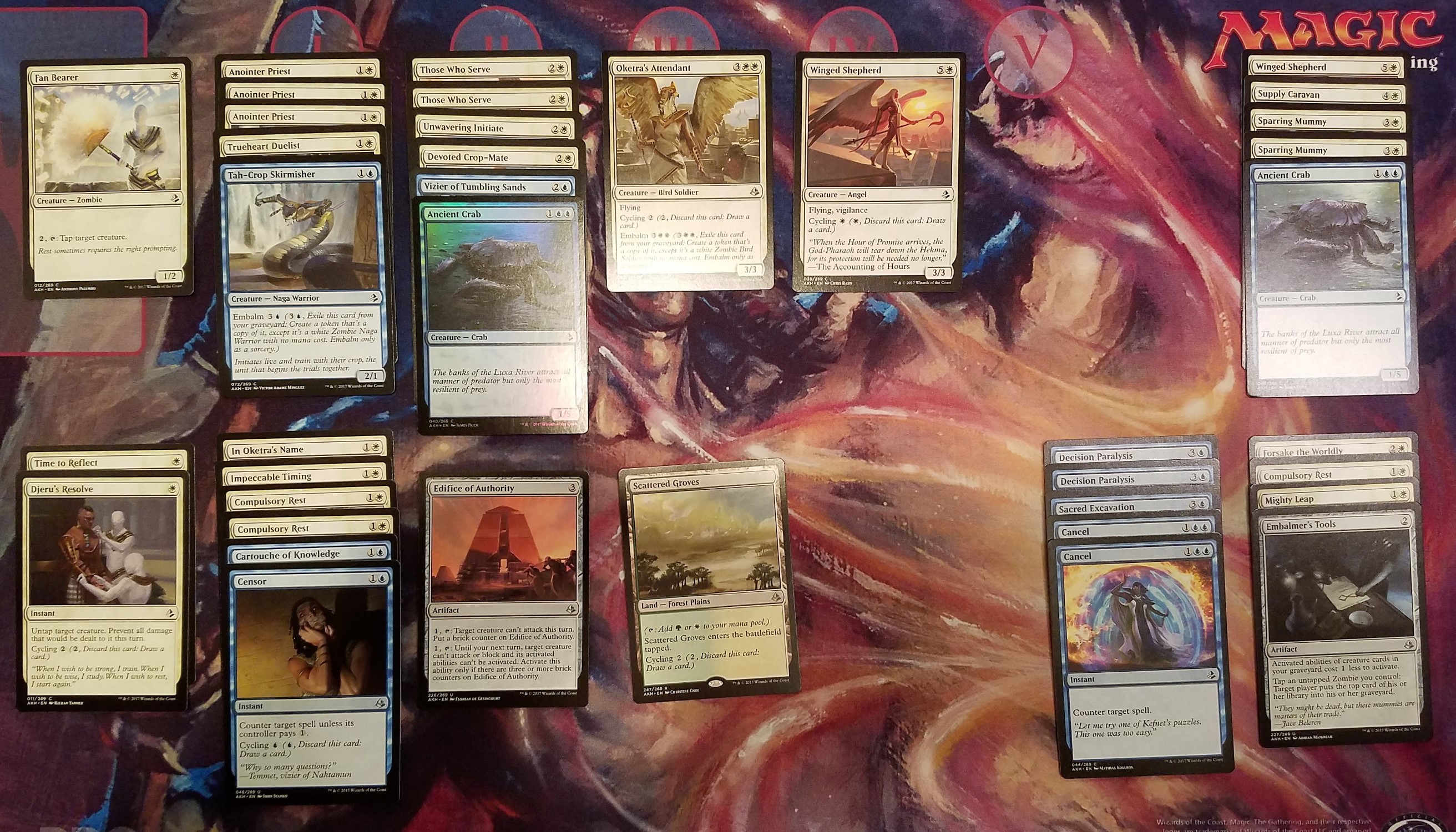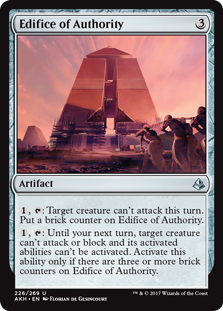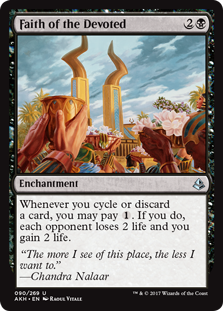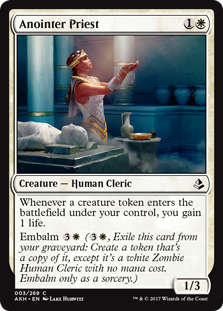
By now, it’s pretty clear that the best of the best Amonkhet draft decks are fast. Of course, not every player in the pod can draft R/W with a curve that tops out barely above 3 CMC, and good decks exist beyond the uber-aggressive. That’s not to mention that you may well find yourself at a table with fewer than a handful of players who actually play frequently or pay attention to what top-level players are reporting about the format.
So the plan, then – if you’re not quite able to race the fastest deck in the pod – is often to blank threats long enough to beat face with fliers or creatures big enough that they functionally become 2-for-1s in combat. Amonkhet provides a lot of options to keep aggro at bay while providing incremental steps toward victory. Your job is to draft a deck that will get you there, or have fun trying. With that, I’d like to share a deck I drafted the other night, what worked and where I think it went wrong.
Amonkhet Draft List: U/W Embalm (5-15-2017)
| Creatures (14) 1 Ancient Crab 3 Anointer Priest 1 Devoted Crop-Mate 1 Fan Bearer 1 Oketra’s Attendant 1 Tah-Crop Skirmisher 2 Those Who Serve 1 Trueheart Duelist 1 Unwavering Initiate 1 Vizier of Tumbling Sands 1 Winged Shepherd Spells (5) 1 Censor 1 Djeru’s Resolve 1 Impeccable Timing 1 In Oketra’s Name 1 Time to Reflect Enchantments (3) 1 Cartouche of Knowledge 2 Compulsory Rest Artifacts (1) 1 Edifice of Authority | Lands (17) 1 Scattered Groves 9 Plains 7 Island On-Color Sideboard (13) 1 Ancient Crab 2 Sparring Mummy 1 Supply Caravan 1 Winged Shepherd 2 Cancel 2 Decision Paralysis 1 Forsake the Worldly 1 Mighty Leap 1 Sacred Excavation 1 Embalmer’s Tools |
Deck Tech
I’d like to start off by mentioning that the deck shown above is the list as it stood at the end of the night. Notable changes from the starting list include removal of the third Compulsory Rest for an Impeccable Timing, two Sparring Mummy for an Ancient Crab and Winged Shepherd, and Forsake the Worldly for a 17th land. Other pieces like Mighty Leap and Forsake the Worldly came back in when they seemed appropriate (I’m looking at you, Drake Haven…).

It may not be Icy Manipulator, but this will do.
Despite having a relatively low curve, this deck ended up being almost entirely defensive. Pack 1 Pick 1 was an easy Edifice of Authority. In the absence of a bomb, Edifice of Authority does a great job keeping you open during the early draft phase, and in combat, it more or less blanks your opponent’s best creature. This was followed up by other Pack 1 picks like Fan Bearer and Compulsory Rest to further control threats. Cards like Those Who Serve, Vizier of Tumbling Sands and Trueheart Duelist love to sit around soaking up damage, and Anointer Priest will happily do so multiple times for one card, gaining you incremental life in the process.
One aspect of the deck that played out well was that despite the high defense, it had a fair amount of reactivity. An opponent eager to rush out their 5/5 River Serpent or an early reduced cost Cryptic Serpent are almost never going to play around Censor, and even if they do, there’s often not much they can do about Time to Reflect exiling for blocking a zombie or Embalmed creature, or Djeru’s Resolve letting me turn a multi-block situation in less of a back-breaking wipeout.
Vizier of Tumbling Sands proved to be an all-star. In early games with land issues, she was a 1/3 mana rock that blocked, and later in the game, she cycled to draw a card while untapping a surprise blocker. Finally, there were numerous times where the higher average toughness on my creatures meant that pumping with In Oketra’s Name could represent an almost completely one-sided board wipe if my opponent tried to alpha.
Match 1 vs. U/B Cycling
This first match was rough. I found myself with only 3 lands for the first 7-or-so turns. Thankfully, my low curve meant that I still got to do something nearly every turn, but an Embalm deck really wants to soak up your extra mana while you also drop new threats. Embalm is virtual card advantage, and when you only have 3 or 4 lands for the entirety of the game, having cards to play is not a problem. On my side, the game quickly became about figuring out which chump blockers to drop or what sort of minor advantages I could eke out while my opponent Cycled his way to victory.

I agree, Chandra. I agree.
On my opponent’s side, I saw a major Turn 3 Cycling payoff, Faith of the Devoted, in Game 1. A Pitiless Vizier or two and Wasteland Scorpion were enough to stop what aggression I was able to play out, while he Cycled through multiple River Serpents, followed by Wander in Death to return two creatures from graveyard to hand and do it over again. Draining 2 life for only 1 generic mana every time you cycle adds up quickly! I was left with few choices other than showing my opponent as little of my deck as possible while drawing out the game long enough to hopefully see him brick on Cycling, giving me an opening of some sort.
Game 2 was an almost identical match, with my deck once again refusing to produce mana for several turns, but this time my opponent dropped a Turn 3 Drake Haven, followed by the return of Faith of the Devoted the next. At this time, I was mainboarding enchantment removal in the form of Forsake the Worldly. I was fortunate to draw into it early enough to exile the Drake Haven with only two Drakes hitting the battlefield, but Faith of the Devoted early game in a deck with almost exclusively Cyclers provided too much inevitability. If you have the right support, Forsake creates a 4-8 point life total swing every turn, and your opponent may well struggle to win that race.
Match 2 vs. R/B Aggro Spells
My second match went much, much better. After Match 1, I became less confident that 16 lands was enough, and I made the switch to 17. While it ended up working well, I’m still not certain if that was the right move, or if I was leaning too heavily on the information I had from a small number of games. The inclusion of Scattered Groves and mana sinks like Embalm and Cycling make me lean toward 17 lands for this deck, but an argument could be made that I just did not play enough games to have the right answer here.
Early drops like Edifice of Authority and Fan Bearer with my any combination of blockers almost entirely shut down multiple copies of the Prowess-enabled Nimble-Blade Khenra, dragon-breathing Minotaur Sureshot, Flameblade Adept, etc. My opponent was also forced into a situation where he needed to spend Magma Spray and other tricks to remove stuff in combat, rather than preemptively, losing out on most of the Prowess damage he could have inflicted.
In the end, both games were won in the skies with Oketra’s Attendant, Winged Shepherd, or any one of my creatures with a Cartouche of Knowledge getting in for 3 damage a turn to seal the deal.
Match 3 vs…. BYE
Unfortunately someone dropped, and I was given a bye. It was disappointing to miss out on the opportunity to really push this deck further and see how another matchup played out, but there’s not much you can do about players dropping at the end of the night. And I don’t hold that against them.
What Worked?
If you’ve made it this far, you can guess that a fairly incredible amount of early game toughness won me Match 2 and kept Match 1 from being a complete blow-out. I would have liked to see this deck perform against a third, because my final selection of cards seemed to be just diverse enough to deal with a lot of cards that can cause an Amonkhet limited game to turn quickly sideways. Magma Spray and -1/-1 counters did very little against this deck, be it due to toughness or Embalm.
I think a big takeaway for me was that even a defensive or mid-range deck has no choice to but to run a curve fairly heavy on 2- and 3-drops overall. You just cannot expect to be very successful if your action starts at 3 CMC. Any strategy you pick needs to accommodate the speed of the format. I thankfully found a nice mix of 1- and 2-drop answers that stopped a number of different threats, and the overall low curve meant that I almost never had a dead card, even when horrendously short on mana.
It’s also important for me to note that I had not drafted a deck quite like this in Amonkhet before. I had a lot of opportunities early on to end up in a fairly solid B/G -1/-1 deck (and it hurt to pass Decimator Beetles), but I’ve ended up with Jund colors enough in Amonkhet drafts that I wanted to branch out a bit. I will happily take a rough beating or two if it means learning something new and becoming comfortable with a more diverse set of archetypes.
What Went Wrong?
My biggest mistake during the draft may have been going too deep into white without many of the actual best white cards. I saw a lot of white coming my way, but it wasn’t what I ended up needing. I clearly did not read the signals well enough to notice that I was not passed a single Gust Walker or Tah-Crop Elite, for example, until it was probably too late. There were opportunities fairly early on to dive into BW Zombies with more than one copy of Wayward Servant, but early pickups of Censor, Cartouche of Knowledge and Vizier of Tumbling Sands may have clouded my decisions. The final build is a bit embarrassing in hindsight, since those are really the only great blue picks I ended up running.

Anointer Priest went wrong.
Similarly, picking up three copies of Anointer Priest just did not pan out. The dream is to take advantage of the Priest’s token-based life gain. In reality, it was almost always a 1/3 that eventually became a chump blocker, and I almost never found myself happy to get an additional block and 1 to 2 points of life for the 3W Embalm cost. Besides providing early game blocking, it never felt like a great use of my mana. This deck is one of the few builds that could benefit greatly from a Sacred Cat or two. With the Priests, most of my board states with Sacred Cat could have actually build up a respectable life swing; chump blocking two creatures to stop 4-6 damage while gaining 3-4 life in the process. Even then, I believe I overvalued Anointer Priest by a fair bit.
At the end of the day, the deck performed very well when it worked, and surprisingly well when it failed. But the bottom line is that it could have been significantly more effective if the deck was more focused. It wasn’t deep enough in tokens for Anointer Priest to go off. It didn’t fly enough to provide enough consistent pressure in the skies. Most importantly, this deck was missing a few key pieces of aggressive tech to really put the pressure on. The result was that I ended up running a lot of cards that are frankly the second-best at what they do, and that’s just not good enough.